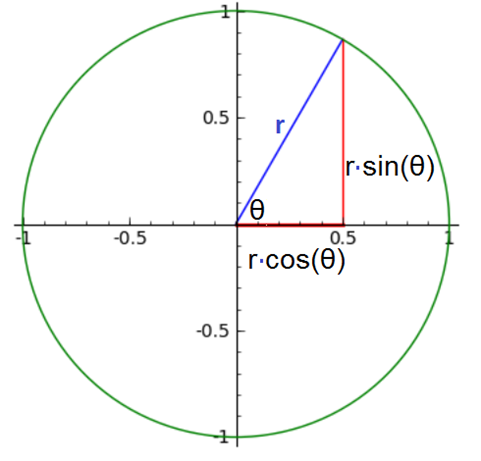Derive the Area of a Circle
There are several ways to go about finding $Area=\pi r^{2}$ for a circle and none of them are necessarily easy. My derivation uses a direct integration method. This section is somewhat of a distraction to everything else about the circle and it may be skipped without loss of context.
In order to find the area inside a circle, which should be known as the area of a disc, we will construct a circle for the purpose of symbol reference.

Proof. From Pythagoras we can begin with a circle defined by $x^{2}+y^{2}=r^{2}$. Solving for $y$ we get $$y=(r^{2}-x^{2})^{1/2} \tag{1} \label{1}$$ which we will rewrite in order to move an $r$ outside the root. So put an $\frac{r^{2}}{r^{2}}$ inside the root. The reason for this algebraic nonsense is to permit a useful trig substitution. $$y=\sqrt{\frac{r^{2}(r^{2}-x^{2})}{r^{2}}}=r\sqrt{\frac{r^{2}-x^{2}}{r^{2}}}=r\sqrt{1-\frac{x^{2}}{r^{2}}}=r\left(1-\frac{x^{2}}{r^{2}}\right)^{1/2} \tag{2} \label{2}.$$
Now we can integrate both sides and I will show how to do the integration. $$\frac{dy}{dx}=\int_{0}^{2\pi}r\left(1-\frac{x^{2}}{r^{2}}\right)^{1/2}dx \tag{3} \label{3}$$ Now for the substitution, using the circle in figure 2, substitute $r\cdot cos\theta=x$ thus $\left(\frac{x}{r}=cos\theta\right)$ so $\frac{x^{2}}{r^{2}}=cos^{2}\theta$. If we are going to substitute for $x$, we also have to substitute for $dx$. Since $x=r\cdot\cos\theta$, $$\frac{dx}{d\theta}=r\left(-sin(\theta)\right)\qquad\text{and}$$ $$dx=r\left(-sin\theta\right)d\theta.$$ Showing the substitution into $\eqref{3}$ (omitting the limits of integration for now), $$\frac{dy}{dx}=\int r\left(1-cos^{2}\theta\right)^{1/2}\cdot r\left(-sin\theta\right)d\theta=\int r^{2}\left(1-cos^{2}\theta\right)^{1/2}\left(-sin\theta\right)d\theta. \tag{4} \label{4}$$ Next change $1-cos^{2}\theta$ to $sin^{2}\theta$ to get $$\int r^{2}\sqrt{sin^{2}\theta}\left(-sin\theta\right)d\theta$$ $$=\int r^{2}\left(-sin\theta\right)\left(-sin\theta\right)d\theta$$ The square root of $sin^{2}\theta$ is $\pm sin\theta$. Since we want the integral to end up positive, we are keeping the negative root here. $$=r^{2}\int sin^{2}\theta d\theta. \tag{5} \label{5}$$ Note that in the last step we moved the constant $r^{2}$ outside the integral sign. From here, the integral can be looked up in a table, but we will continue and find it another way. Because the remainder of this involves trig substitutions that are not very often used, it makes a lot of sense to just stop here using the table integral. The table integral is $\int sin^{2}x\ dx=\frac{x}{2}-\frac{sin(2x)}{4}$.
Continuing, there is a trig identity from the double-angle formula which shows $$cos(2\theta)=1-2sin^{2}\theta$$ and by rearrangement,$$sin^{2}\theta=\frac{1}{2}-\frac{1}{2}cos(2\theta).$$ Making this substitution into $\eqref{5}$ gives $$=r^{2}\int\left(\frac{1}{2}-\frac{1}{2}cos(2\theta)\right)d\theta.$$ Finally, we are ready to integrate. Begin by linearizing.$$\frac{dy}{dx}=r^{2}\int\frac{1}{2}d\theta-r^{2}\int\frac{1}{2}cos(2\theta)d\theta \tag{6} \label{6}$$ The left term integral is easy. It is $\theta r^{2}/2$. Plug that in, and move the constant out of the integral on the right also. $$\frac{dy}{dx}=\frac{\theta r^{2}}{2}-\frac{r^{2}}{2}\int cos(2\theta)d\theta \tag{7} \label{7}$$ Now for the right integral term.$$\int cos(2\theta)d\theta,$$ Substitute $u=2\theta$. Then $\frac{du}{d\theta}=2$ and $d\theta=\frac{1}{2}du$,so $$\int\cos(u)\cdot\frac{1}{2}du$$ $$=\frac{1}{2}cos(u)\,du$$ $$\int cos(2\theta)d\theta=\frac{sin(u)}{2}$$ Next, undo the substitution: $$\int cos(2\theta)d\theta=\frac{sin(2\theta)}{2}$$ Plug that back into $\eqref{7}$, $$\frac{dy}{dx}=\frac{\theta r^{2}}{2}-\frac{r^{2}}{2}\frac{sin(2\theta)}{2}$$ combine terms and apply the limits of integration. $$\frac{dy}{dx}=\left[\frac{2r^{2}\theta}{4}-\frac{r^{2}sin(2\theta)}{4}\right]_{0}^{2\pi}$$ $$=\left[\frac{2r^{2}2\pi}{4}-\frac{r^{2}sin(2\cdot2\pi)}{4}\right]-\left[\frac{2r^{2}0}{4}-\frac{r^{2}sin(2\cdot0)}{4}\right]$$ Of the four terms, the 2nd, 3rd, and 4th dissolve to zero, and the first term reduces to $\pi r^2$. $$Area=\frac{dy}{dx}=\pi r^{2}$$